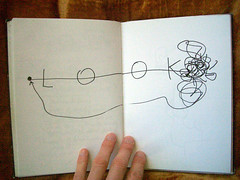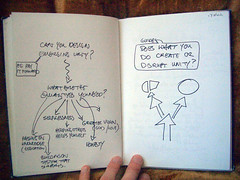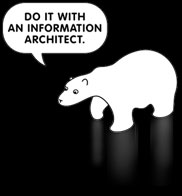
Design Thinking
"Design's value is in asking great questions as much as finding great answers."
Beim Design Thinking kombiniert man kreative und analytische Herangehensweisen um spezifische Probleme zu lösen. Was bedeutet "Herangehensweise"? Nun, es geht um das organisieren von Ideen und Informationen um darauf aufbauend Entscheidungen zu treffen, Situationen zu verbessern und Wissen zu erlangen.
Analytisch und Kreativ. Also left brain, right brain. Aus Vergangenem lernen. Welche Beobachtungen hat man gemacht, welche Erkentnisse gesammelt? Konnte ein Muster, ein Pattern festgestellt werden? Sich die Zukunft vorstellend: Welche Möglichkeiten sind denkbar? Was sind Chancen und Risiken?
Beim Design Thinking geht es um einen Design-geführten Innovationsprozess. Im Mittelpunkt dieses Prozesses steht der Nutzer. Es ist also notwendig den Blickwinkel zu wechseln. Nicht der eigene Standpunkt zählt sondern der des Anwenders.
Eine Recherche- und Beobachtungsphase beginnt im Konkreten. Aus gesammelten Einsichten wird ein Framework erstellt. Hier befindet man sich nun im Abstrakten. Nun geht es wieder zurück zum Konkreten: Welche Strategien lassen sich verfolgen? Welche Gelegenheiten und Möglichkeiten lassen sich identifizieren?
Beim Design Thinking gilt:
- Innovation findet nicht im Luftleeren Raum statt. Es muss ein passendes Umfeld geschaffen werden und das passiert am besten top-down.
- nnovation ist ein Teamsport.
- Anwender und Kunden sollten im Zentrum dessen stehen, was man macht. Das bedeutet aber nicht, dass man alles machen oder glauben muss, was diese sagen.
- Es wird ein System benötigt welches es erlaubt aus Fehlern zu lernen. Fehler passieren immer. Lieber früher als später. Frühe Fehler sind billig, ja vielleicht sogar wertvoll. Späte Fehler sind teuer.
Innovation kann unterschiedlich daher kommen. Revolutionär oder evolutionär. Wie auch immer man zu Innovation kommt, im Idealfall ist sie ein Nebenprodukt des Design Thinking Prozesses.
Was soll da jetzt neu dran sein?
Beobachten und nachfragen sind wichtige Bestandteile des Design Thinking. Was liegt hinter dem Offensichtlichen? Welche Fragen bringen einen weiter? So etwas schafft man kaum alleine. Hierzu wird ein kreatives, motiviertes und experimentierfreudiges Team benötigt. Daher müssen Wände abgebaut und Türen geöffnet werden. Gespräche finden schlecht durch geschlossene Türen hindurch statt. Beobachten heisst, dass man das meiste nicht am Arbeitsplatz lernt. Schon gar nicht, wenn man alleine im Büro herumsitzt. Es geht um Beobachten im Kontext des Anwenders, es geht um Einfühlungsvermögen.
Wie macht man sich selbst fit für die neue Ära des Design Thinking? Da gibt es den Ausspruch, "mache dich T-förmig". Breites Kreuz und schlanker Body? Na ja, so ähnlich. Becoming t-shaped bedeutet breit aufgestellt zu sein und unterschiedliche Skills zu haben, aber zusätzlich in einem Gebiet ein Spezialist zu sein (das ist der vertikal Strich vom "T", also die Tiefe in welche das eigene Wissen herabreicht. Kopfkino: Jacques Cousteau im Wissenssilo). Schon Don Norman fragte auf irgendeiner Konferenz "warum lesen so wenige Designer Business Artikel?" warum interessieren sich so wenige Entwickler für Design (oder Designer für Entwicklungsprozesse)?
Es kann natürlich nicht jeder ein Entwickler, ein Informationsarchitekt oder ein Designer sein - aber jeder kann ein Design Thinker werden.
Die Stanford d.school hat sich folgendes Manifest auf die Fahnen (ursprünglich auf eine Serviette) geschrieben:
- prepare future innovators to be breakthroug thinkers and doers.
- use design thinking to inspire multidisciplinary teams
- foster radical collaboration between students, faculty and industry
- tackle big projects and use prototyping to discover new solutions
"Prototyping is a process of learning", heisst es. Inspiration erhöht die Menge an Prototypen. Validierung dampft diese wieder auf ein brauchbares Maß ein.
The Economist schreibt zum Thema Design Thinking: "Roger Martin, head of the Rotman School of Management at the University of Toronto and a pioneer in this field, says that true “design thinking” involves a deep understanding of people’s habits and preferences. As evidence, he points to the expensive Aeron chair, which Herman Miller designed based on lengthy observation, not just answers given in focus groups."

Service Design
Services sind ja ein schwieriger Produkt-Typ: sie sind nicht wirklich greifbar, man kann sie nicht speichern oder transportieren und ihre Qualität lässt sich schwer messen. Dennoch müssen sie designed werden, wie andere Produkte auch. Auch Dienstleistungen (der sogenannte tertiäre Sektor) brauchen Design - und mit Design sind immer bestimmte Prozesse gemeint, es geht nicht um "hübsch machen" oder "pixelgenau positionieren".
Haben unsere Eltern oft noch mit handwerklicher Arbeit Geld verdient, sind spätestens in unserer Generation Services zu einem wichtigen Bestandteil moderner Wirtschaft und des sozialen Systems geworden.
Beim Service Design werden die bereits erwähnten Design Thinking Methoden angewandt, um vorhandene Services zu verbessern oder neue zu erstellen. Nutzer werden beobachtet. Erkenntnisse füttern Ideen. Aus Ideen werden Zeichnungen (Service Szenarien) oder Service Prototypen. Es folgt eine Evaluationsphase mit anschließender Umsetzung und so weiter.
Idealerweise kommen im Sevice Design explorierende, generierende und evaluierende Design-Ansätze nacheinander zum Einsatz. Das kennt manch einer aus dem Produkt- oder Interface Design in dessen Tradition Service Design steht.
Wendet man Design Techniken auf Service Produkte an, kommt man auch dort zu besseren Ergebnissen, erreicht eine höhere Kundenzufriedenheit, eine bessere Qualität und höhere Einnahmen.
Wichtig ist, dass Service Design als ganzheitlicher, also holistischer Ansatz zu verstehen ist. Mit dem Anwender im Zentrum werden alle Service Touchpoints betrachtet und analysiert und in multidisziplinären Teams zu verbessern versucht.
"Der Begriff des Service Designs erklärt sich noch nicht von selbst. Design wird meist mit Produkten und deren Styling, vielleicht noch mit der grafischen Gestaltung
eines Logos, Layouts oder dem Corporate Design eines Unternehmens in Verbindung gebracht. Im Mittelpunkt des Service Designs allerdings steht die Gestaltung der Dienstleistungsschnittstelle aus der Sicht des Kunden" sagt Professor Birgit Mager (Leiterin des Lehrstuhl für Service Design an der Köln International School of Design).
Human-centered bedeutet auch im Service Design mehr als nur Ergonomie. Es geht vielmehr darum Kultur und Kontext zu verstehen. Erst dann kann man anfangen Ideen zu entwickeln.
Die Sicht des Kunden oder Bedürfnisse von Nutzern sind für manchen eine ganz neue Entdeckung. Für Informationsarchitekten und User Experience Designer sind sie Teil der täglichen Arbeit.
Dennoch ist es sehr erfreulich zu sehen, dass sich immer neue Fachbereiche und Berufsgruppen für Design Thinking und Service Design interessieren. Man muss aber auch zugeben, dass es zwei sehr sexy Begriffe sind. Was ein frisches Wording bewirken kann, haben wir ja alle bei Microsofts XMLHttpRequest genannter asynchroner JavaScript Technologie gesehen. Nachdem sich jahrelang kaum jemand dafür begeistern konnte, kam 2005 jemand darauf, dass man das Ganze ja auch "Ajax" nennen könnte...
...und der Rest ist Geschichte.
Hier ist übrigens eine tolle Präsentation von Sylvain Cottong zum Thema: UX design, service design and design thinking.
IA Konferenz 2010
Das Motto der nächsten Deutschen Konferenz für Informationsarchitektur (IA Konferenz) lautet Service. Design. Thinking. Die Konferenz wird am 14. und 15. mai in Köln stattfinden. Der Call for Papers ist bereits eröffnet.
Images by Paul Hughes (Design Thinking's photostream).












